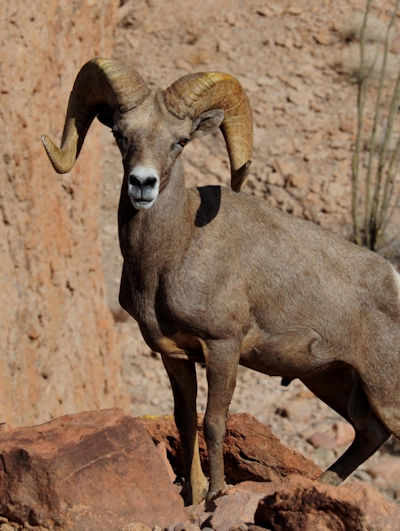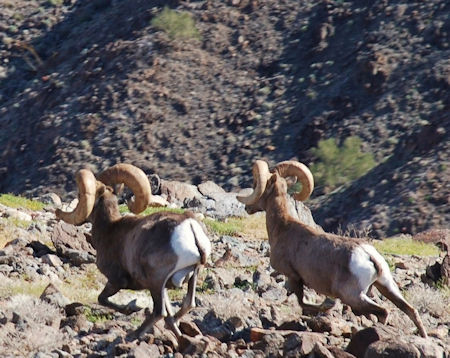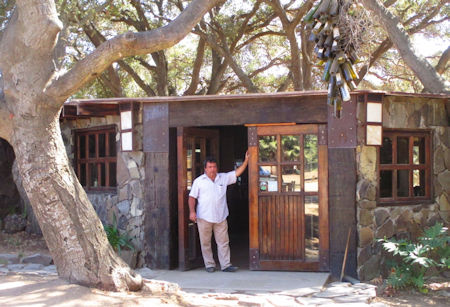 |  |
By Martina

Deep in the shade of the old-growth live oak trees, where the Kumiai Indians once roamed, is a storyteller in the truest sense of the word. A storyteller informs the community about things they may not have experienced, while at the same time leaves a deeper message imbedded to be discovered by those who can hear. Stepping into the rustic restaurant, Quercus, I am to meet Biologist Federico Cota Campbell, who has lived a lifetime learning about and understanding the ways of nature. He has followed the majestic borrego cimarron, the bighorn sheep, Baja California’s state symbol, through wild and rugged terrain. He was a member of one of the first teams sent by the Mexican government to discover how the majestic bighorn were faring at the turn of the 21st century.
A story is a living thing and will often take the storyteller in directions that were not intended and so it was with the story of the bighorn sheep. Federico is a dramatic and impassioned speaker as he reaches for a piece of paper and begins to draw a map of the Baja peninsula. He first lays out the history and the politics that enters into managing any area of wildlife in these modern times of diminishing free range and man’s impact on the environment. His opportunity came just as he had gotten his degree in Biology. He had been fascinated by nature and all living things from a very young age. He grew upon on a rancho east of Puerto Nuevo, the now famous lobster village south of Rosarito. He was free to roam the hills in his own unique form of study. With sparkling eyes he reminisces about how it was growing up, “I wanted to understand how everything worked and why. I would go out and walk for a whole day, because of my fascination. I was hungry for knowledge. I already knew what I wanted to be and was an excellent field researcher before I even went to school.” He stated, “Nature has all the keys to what is going on. For example, you know you have a healthy environment if you have quail,” and he goes on to explain why. When he talks about the birds and animals, he speaks of their personalities as if they were people. He lines up all the facts backed up by his experience and science.

As it happened he was poised at the perfect time, finishing up his degree in biology in at UABC Ensenada, just as in 1990 the Mexican government was talking about a conservation strategy for the wild sheep. Federico was a natural. The teams were formed, however funding and the go ahead did not come through until 1992. The trek into the wilds of Baja California began. The research was taken in a specific area of Arroyo Grande, as this was the home of the biggest trophy species for hunters. The focus was to understand how to best conserve the species and subspecies. The desert and mountainous terrain was physically challenging.
Federico admits it was a challenge, “I was young and was leaving my future wife behind for several weeks at a time.” But he continues with such excitement, “We were going where there was no trace of humanity. At first I was not in very good shape and it was unnerving to see the steep rocky terrain we had to climb. Since we followed the sheep, we had to be up at 4:00 am with them. They would move about until 9:00 am when it began to be too hot. Then they took to shady crevices and we did too. We played games, ate, updated our records or slept until late afternoon when the sheep became active again.” Federico grins and said, “We also challenged one another with who could get the first sighting!”
Federico pulls out a small book and opens it up to show tiny writing and drawings of his field notes and explains the process, the where, when and how many rams, ewes and lambs were spotted in one day. The team was made up of two scientists and two guides who knew the terrain. “They were men, like 70 year old Don Lupe, who had an understanding of life. I understood them, because it was how I was raised. They saw that I also knew.” These men could survive the harshest of lifestyles and hunted the sheep for food. Here is where Federico becomes very adamant as a scientist. All scientists agree that in order to maintain the species in these times, management is a must. It is as complex as nature herself. The balance of nature is perfect, it is man’s ignorance that has brought on the imbalance.

Admittedly this is a very sensitive topic. In the past all hunting fees were paid to Mexico City and landowners had no say as to hunting on their land. Now, licenses are sold at the state level. It is astonishing to consider that a hunter is willing to pay tens of thousands of dollars to bring in a trophy ram, however now the rancher receives what the hunter is willing to pay him as a guide into the wilderness. The protection of the bighorn is given directly to the landowners who have lived there for generations. Federico asks, “Why wouldn’t someone want to do this, versus running 20 cows through the scrub for a living?” They become the stewards for the bighorn if they meet the compliances for a healthy herd. And Federico explains, “there are strategies like Ecological Cleansing which removes all introduction of exotic animals that compete for food and water, bringing diseases, from their environment and a there's a High Fence strategy, confining a reproductive herd to minimize predation and restock the free herds. I want to set the record straight. Management is the only solution. And finally this idea started moving forward in 2013. Science is telling us the reality and reliable research is very important.”
Because the bighorn move freely among mountain ranges, it is not easy to get a definite count. However, a review of the results from 1992 to 2010 shows that there is “no indication that the bighorn sheep has decreased…there is some evidence of an increase.” Federico speaks freely of his admiration for the bighorn. “I had an interaction with a ram that was protecting his herd. He saw me and ran upwards to where I was, stopping a few yards away and stood his ground. He suddenly stomped his hoof. Boom, boom, boom. I took a few steps forward. He retreated the same distance, turned, stood his ground, boom, boom, boom. We looked at each other. He was so impressive, I was completely blown away.”

References:
Federico Cota Campbell, Quercus Restaurante
cotafederico(at)yahoo.com
California Fish and Game
Hunting Report Newsletter
Martina's email: mteomaya(at)gmail.com

Very easy process to purchase online. Very reasonable rates. Lots of good insight and helpful...

Easy to buy! I didn’t have to use it, so no clue on that front

I have been using Baja Bound Insurance for years. It is the best place to purchase Mexican auto...